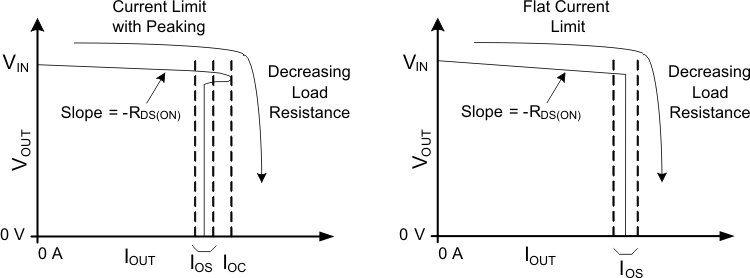SLVS514P April 2004 – August 2024 TPS2041B , TPS2042B , TPS2043B , TPS2044B , TPS2051B , TPS2052B , TPS2053B , TPS2054B
PRODUCTION DATA
- 1
- 1 Features
- 2 Applications
- 3 Description
- 4 General Switch Catalog
- 5 Pin Configuration and Functions
- 6 Specifications
- 7 Parameter Measurement Information
- 8 Detailed Description
- 9 Application and Implementation
- 10Power Supply Recommendations
- 11Layout
- 12Device and Documentation Support
- 13Revision History
- 14Mechanical, Packaging, and Orderable Information
8.3.7 Overcurrent
A sense FET is employed to check for overcurrent conditions. Unlike current-sense resistors, sense FETs do not increase the series resistance of the current path. When an overcurrent condition is detected, the device maintains a constant output current and reduces the output voltage accordingly. Complete shutdown occurs only if the fault is present long enough to activate thermal limiting.
There are two kinds of current limit profiles for the TPS20xxB family of devices.
The TPS20x3BD, TPS20x4BD, and TPS20x2BDRB devices have an output I vs V characteristic similar to the plot labeled Current Limit with Peaking in Figure 8-5. This type of limiting can be characterized by two parameters, the overcurrent trip threshold (IOC), and the short-circuit output current threshold (IOS).
The TPS20x1B and TPS20x2B devices in the D, DGN, and DBV packages have an output I vs V characteristic similar to the plot labeled Flat Current Limit in Figure 8-5. This type of limiting can be characterized by one parameters, the short circuit current (IOS).
 Figure 8-5 Current Limit Profiles
Figure 8-5 Current Limit Profiles